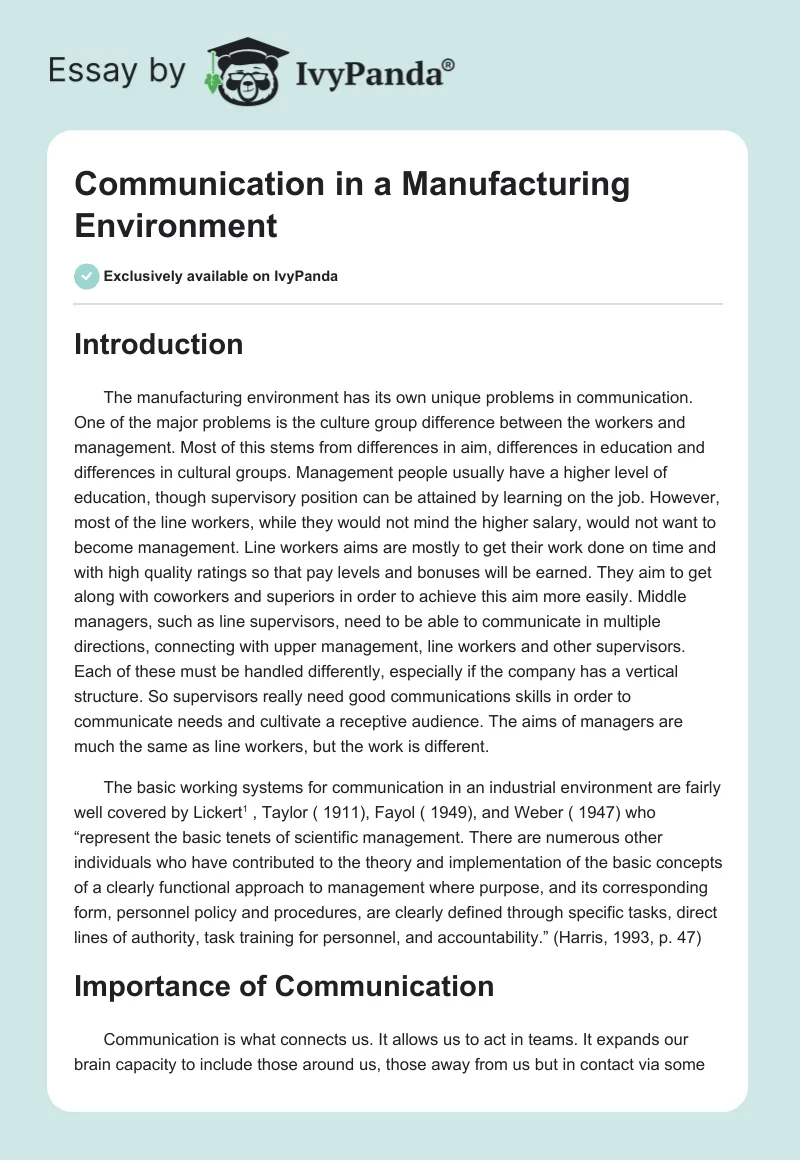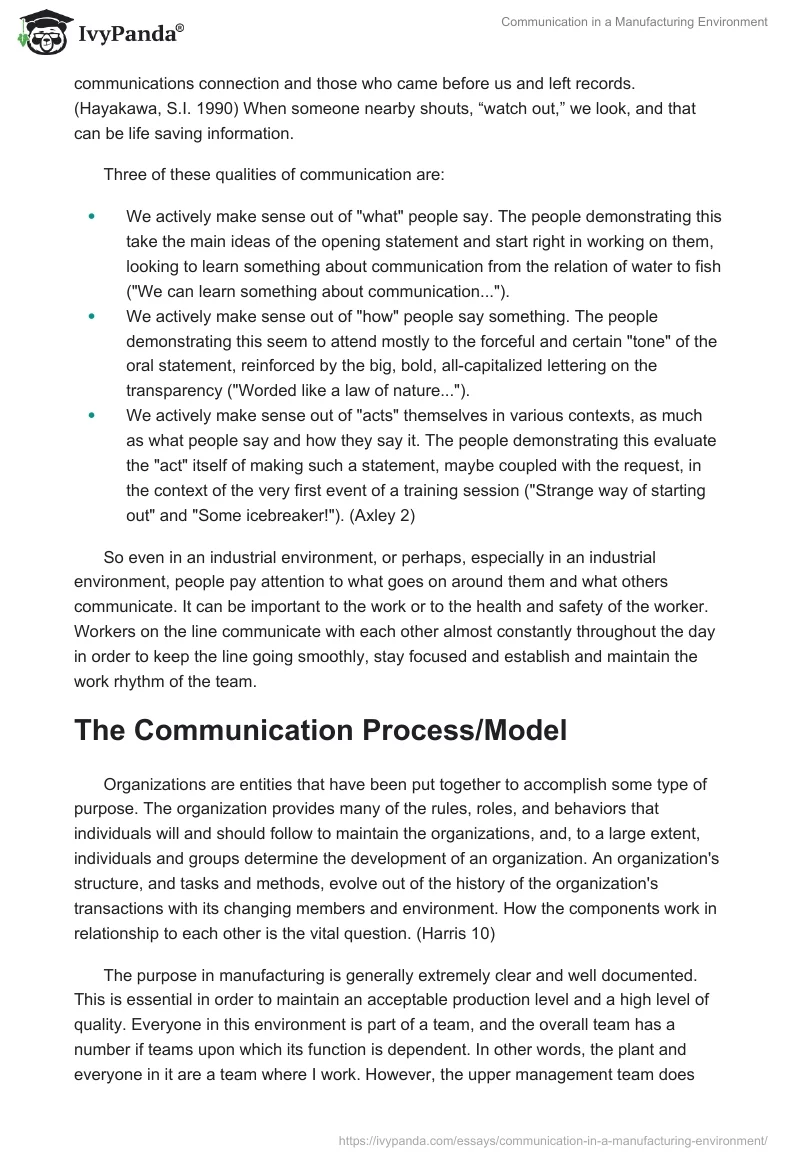Introduction
The manufacturing environment has its own unique problems in communication. One of the major problems is the culture group difference between the workers and management. Most of this stems from differences in aim, differences in education and differences in cultural groups. Management people usually have a higher level of education, though supervisory position can be attained by learning on the job. However, most of the line workers, while they would not mind the higher salary, would not want to become management. Line workers aims are mostly to get their work done on time and with high quality ratings so that pay levels and bonuses will be earned. They aim to get along with coworkers and superiors in order to achieve this aim more easily. Middle managers, such as line supervisors, need to be able to communicate in multiple directions, connecting with upper management, line workers and other supervisors. Each of these must be handled differently, especially if the company has a vertical structure. So supervisors really need good communications skills in order to communicate needs and cultivate a receptive audience. The aims of managers are much the same as line workers, but the work is different.
The basic working systems for communication in an industrial environment are fairly well covered by Lickert, Taylor (1911), Fayol (1949), and Weber (1947) who “represent the basic tenets of scientific management. There are numerous other individuals who have contributed to the theory and implementation of the basic concepts of a clearly functional approach to management where purpose, and its corresponding form, personnel policy and procedures, are clearly defined through specific tasks, direct lines of authority, task training for personnel, and accountability.” (Harris, 1993, p. 47)
Importance of Communication
Communication is what connects us. It allows us to act in teams. It expands our brain capacity to include those around us, those away from us but in contact via some communications connection and those who came before us and left records. (Hayakawa, S.I. 1990) When someone nearby shouts, “watch out,” we look, and that can be life saving information.
Three of these qualities of communication are:
- We actively make sense out of “what” people say. The people demonstrating this take the main ideas of the opening statement and start right in working on them, looking to learn something about communication from the relation of water to fish (“We can learn something about communication…”).
- We actively make sense out of “how” people say something. The people demonstrating this seem to attend mostly to the forceful and certain “tone” of the oral statement, reinforced by the big, bold, all-capitalized lettering on the transparency (“Worded like a law of nature…”).
- We actively make sense out of “acts” themselves in various contexts, as much as what people say and how they say it. The people demonstrating this evaluate the “act” itself of making such a statement, maybe coupled with the request, in the context of the very first event of a training session (“Strange way of starting out” and “Some icebreaker!”). (Axley 2).
So even in an industrial environment, or perhaps, especially in an industrial environment, people pay attention to what goes on around them and what others communicate. It can be important to the work or to the health and safety of the worker. Workers on the line communicate with each other almost constantly throughout the day in order to keep the line going smoothly, stay focused and establish and maintain the work rhythm of the team.
The Communication Process/Model
Organizations are entities that have been put together to accomplish some type of purpose. The organization provides many of the rules, roles, and behaviors that individuals will and should follow to maintain the organizations, and, to a large extent, individuals and groups determine the development of an organization. An organization’s structure, and tasks and methods, evolve out of the history of the organization’s transactions with its changing members and environment. How the components work in relationship to each other is the vital question. (Harris 10)
The purpose in manufacturing is generally extremely clear and well documented. This is essential in order to maintain an acceptable production level and a high level of quality. Everyone in this environment is part of a team, and the overall team has a number if teams upon which its function is dependent. In other words, the plant and everyone in it are a team where I work. However, the upper management team does their job and part of that is communicating with me and other supervisors what they need from our teams. Then each supervisor needs to communicate with their team what the needs are that the team must accomplish. This is essential for the smooth operation of the company.
“In the communication process, each individual is both an actor and a reactor to the communication events. ” (Harris 6)
In view of the above, the communicator must remember that the perception of his or her communication has two or more actors. That is, it is not enough to communicate what you mean, but you must also seek to insure that others understand what you mean.
The dynamics of communications process models have been described as a transaction process as follows:
This is extremely important when management is concerned, because there are sociological differences which must be bridged. These differences are represented by rank in industrial settings. There is a social hierarchy that extends from the level of responsibility of the individual that must be considered when communicating. In the manufacturing environment, communication is received differently according to the two or more parties involved. For example, there are within the manufacturing plant, essentially, three levels of communication parings:
- Peer to peer: communications among equals, as defined by level of responsibility.
- Superior to subordinate: that is, one with a higher level of responsibility to those with a lower level of responsibility.
- Subordinate to superior, that is one with lesser responsibility to those with more responsibility.
According to the dynamic the method and process of communication changes. For example, when the line supervisor, such as myself, wants to communicate with his or her subordinates, the line lead and workers, it is a simple process of getting their attention and speaking. The line supervisor knows enough to decide when to interrupt the line work in order to do so. This would of course depend upon the importance of the communication. Many times, if the communication is not an immediate need, the supervisor will wait until a break is imminent and then address the group just before that.
When the same supervisor needs to communicate with the supervisor of another section or the director above his section, her uses the phone and goes through a secretary, who generally puts him through. If this same supervisor wishes to communicate with upper management, he or she makes an appointment via telephone. The knowledge of the hierarchy is known among all those who work within the plant, and the protocol is recognized. It may vary some in different companies, according to the interior business culture and the operations of the company.
Reasons for communication are another consideration. There are two things which must be considered: to whom is the communication important, and why. If a line worker needs an extra day off, that worker is the one to whom this is most important. It is important to the supervisor, because he or she has the responsibility for maintaining production and needs to know the needs of the line workers in order to keep the team productive. In this case, the line worker would make an appointment to speak with the supervisor, and ask for the extra day off. In this manner, the line work will not be disrupted, as the supervisor can arrange a substitute.
Finally, the language of communication and the accompanying body language changes according to the same dynamic pattern. Supervisors may address their superiors slightly differently than they do their subordinates, according to established patterns of protocol. This applies to all pairings of communications groups. The communicator(s) will address the target audience differently, according to established patterns within the company. It is very important not to send “mixed messages”, that is communicating a different message with word than you communicate with tone and body language. In other words, you cannot say you respect the needs of the group unless you really do. Something will give you away, so supervisors, especially, must be certain of their motives before they speak.
Change Management
Managing change is a primary responsibility at the line supervisory level. The communications process for management has different dynamics also, according to the reason for the communication. Management of change is an important responsibility of line supervisors. Therefore, when addressing subordinates to communicate the needs for change and the methods for achieving change, the supervisor must be prepared. The communication must be organized is some manner so that it reaches all the necessary people to implement the change. For example, is the change applies to the work order, as in adding or reducing number, in adding or removing a process, then this must be communicated very clearly orally and also documented and posted where all can see it constantly as a reminds. This is the only method to avoid mistakes for this type of change.
The communications dynamics will also change according to the needs. The needs are generally communicated from upper management to the supervisor on the line concerned by phone call and written memo or order copy. This insures that the supervisor of the line concerned has been notified orally and has a memo which includes all the details. The memo may come down manually or via fax, email or internal mail.
Conclusions
Communication is a dynamic process and is essential for any manufacturing plant to operate smoothly and produce the product that supplies the profit which pays everyone’s wages. There is an established mode and method of communications within the company by virtue of its organizational architecture. Everyone needs to know this process and protocol which is established. Generally this is well documented, and every new worker within the plant is given a copy during orientation.
Supervisors need well practiced communications skills, especially at the mid management level so that their messages are understood and received in a positive manner. The company is a team of teams, and good teams communicate well and often.
References
Harcourt Brace Jovanovich, 1990.
Axley, S. R. (1996). Communication at Work Management and the Communication-Intensive Organization. Westport, CT: Quorum Books. Web.
Fayol H. ( 1949). General and industrial management. New York: Pittman.
Harris, T. E. (1993). Applied Organizational Communication: Perspectives, Principles, and Pragmatics. Hillsdale, NJ: Lawrence Erlbaum Associates. Web.
Hayakawa S. I., and Alan R. Hayakawa. Language in Thought and Action, 5th ed. New York.
Likert R. ( 1961). New patterns of management. New York: McGraw-Hill.
Likert R. ( 1967). The human organization. New York: McGraw-Hill.
Taylor F. W. ( 1911). The principles of scientific management. New York: Harper & Bros.
Tomorrow’s jobs: Overview. ( 1986). Washington, DC: U.S. Department of Labor.
Weber M. ( 1947). The theory of social and economic organizations ( A. M. Henderson & T. Parsons, Trans.). New York: Free Press.
Wilmot W. W., & Wenburg J. R. ( 1973). Communication as transaction. Paper presented at the International Communication Association Convention, Montreal.


